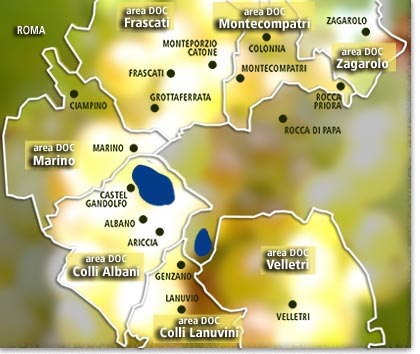 |

Most of the Castelli Romani stand on the external ring of the
volcanic crater of the Colli Tuscolani, stretching over the Colli
Albani till Monte Artemisio (925 above sea-level) to reach the
Maschio Lariano (821 m above the sea-level) and then extending
northward on the Monte Salomone (773 m above the sea-level) to
meet again the Colli Tuscolani. The little internal ring is characterized
by Monte Cavo (949 m above the sea-level) and by Monte Faete (956
m above the sea-level).
Coming from Rome visitors can observe Monte Cavo dominating the
area with its typical flat peak.
It seems to be the central volcano, but it was created by detritus
coming from the eruptions of the principal craters: i.e. the Lakes
of Albano and Nemi and those of Ariccia and Pavona, that have
been drained.
All the grounds nearby have a volcanic origin, even if different
in lava consistency. The same origin characterizes the few alluvial
soils of this zone; thus they are very rich in potassium, an important
element to process sugars, and without calcium. Definitely the
good drainage of these soils is due to their layers. A main condition
however has to be accomplished, i.e. loose volcanic rocks on the
surface level or just a meter underground have to be brought to
the direct exposure of atmospheric agents, so that within two
years their deterioration will form a fertile ground.
Average annual rainfalls range from 750 and 1,000 mms. on the
coastal zone, and reach 1,250 mms. on the hills, where viticulture
is of main interest. On the mountains the average amount of rain
falling during a year is of 1,500 mms. but these are forested.
Spring and autumn are the most rainy seasons, and therefore even
during summer grounds are prepared to receive rain in the depth.
In the soils not very rich in humus is put manure through the
“sovescio” procedure, i.e. by planting during Spring
leguminous plants such as the “favino”, that can fix
the atmospheric nitrogen in their roots, and can produce an abundant
vegetation, which by decomposing fertilize the soil, increasing
the capacity to absorb humidity.
The DOC Wine “Castelli Romani” has been the last one
to be recognized. It has been added to the other DOC wines to
help many producers which have vineyard characterized by only
one type of vine, generally: spotted Malvasia, also named Malvasia
del Lazio or Greco. This aimed also to satisfy consumers different
exigencies and to control red wines production in those areas
where only the white one was already controlled. With the DOC
“Castelli Romani” are controlled not only red wines
but also new wines and rosé.
Production territory: there are areas near to the Castelli Romani
ones, similar in environmental conditions, to expand the cultivation
of those producers already involved in the cultivation in the
areas controlled by the DOC. The producers in these surrounding
areas have the same oenological and agronomical culture of those
of the Castelli Romani; these areas thanks to their environmental
and climatic characteristics have been added to the DOC “Castelli
Romani”.
Therefore, the territory characterized by the general denomination
“Castelli Romani”, consists also of the towns of Rocca
di Papa, and Rocca Priora, and Ciampino and Lariano which recently
have been divided from Marino and Velletri; Zagarolo and San Cesareo
which already formed the Zagarolo DOC; and Cori, Cisterna and
Aprilia, recently included thanks to their geographical and human
conditions. Cori and Aprilia are already characterized by a specific
DOC.
|
|
 |
|

